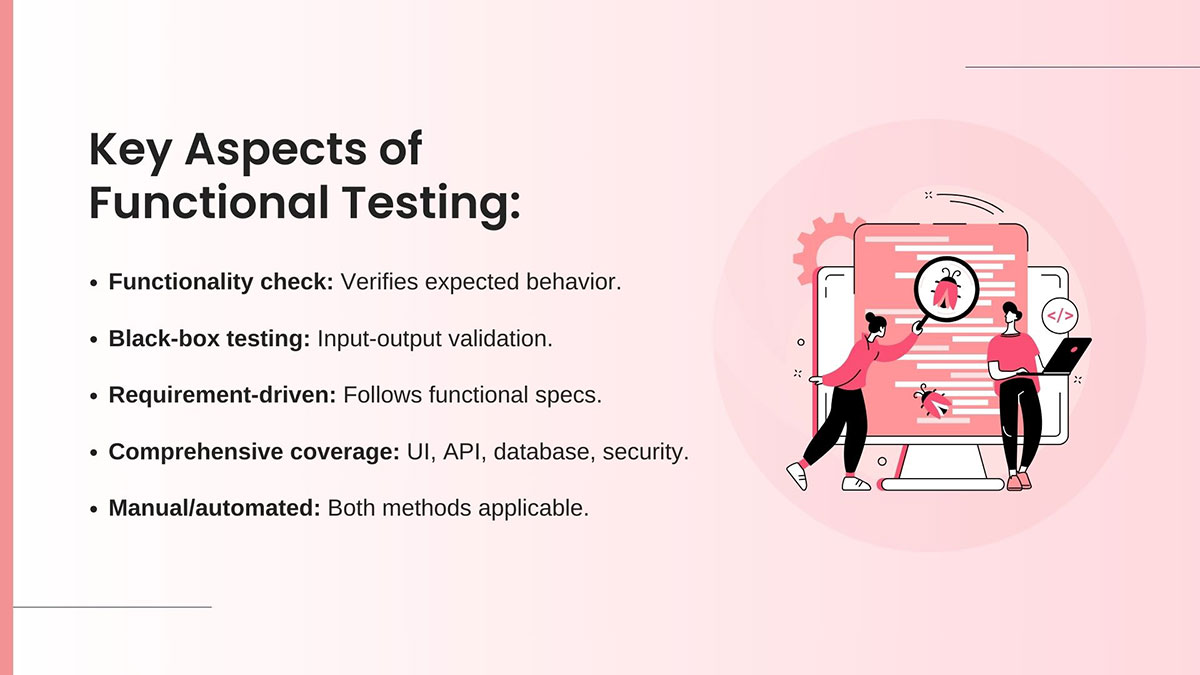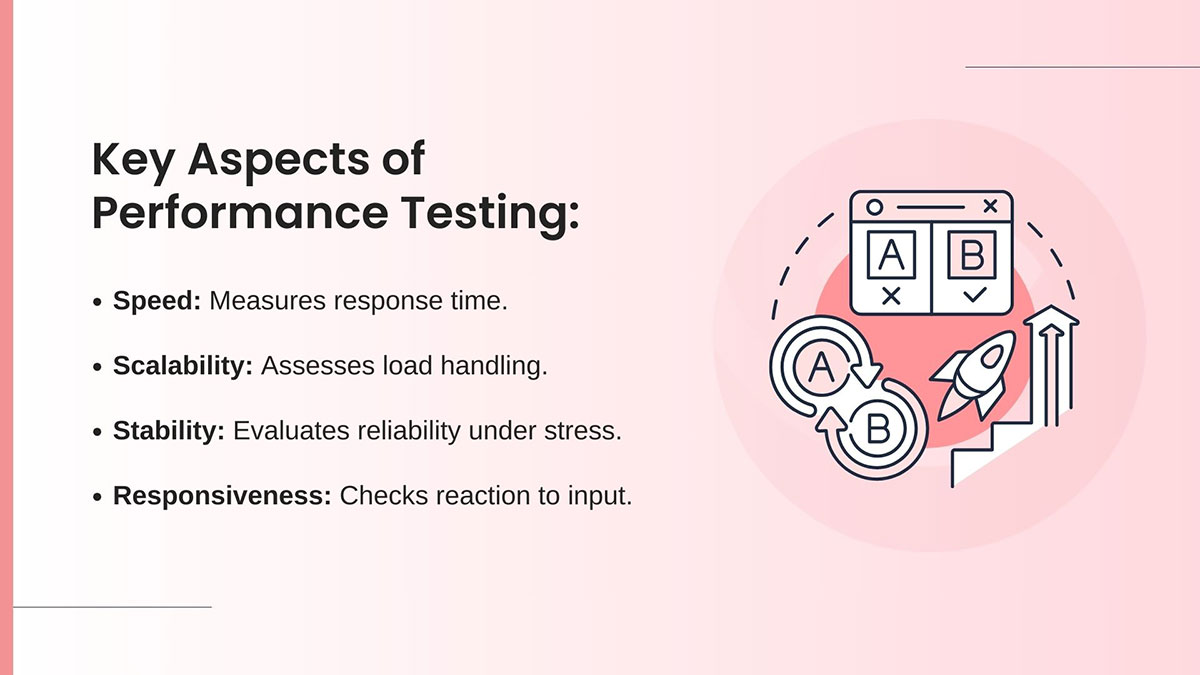Software testing isn’t just about finding bugs; it’s about building software that works, performs, and scales as per business needs. It’s a strategic investment that ensures your application delivers peak performance and user satisfaction. Functional testing validates the logic, APIs, and UI, while performance testing pinpoints bottlenecks, memory leaks, and scalability issues. While each serves a distinct purpose, the question arises: Why is it important to use both in software development? The answer lies in the synergy between these approaches.
Combining these approaches, you can build software that not only works but functions seamlessly for better user experience. Keep reading to know what they are and how this integrated approach leads to higher code quality, optimized application performance, and improved user experience.
What is Functional Testing?
Functional testing is a critical aspect of software development that ensures each component of an application operates as intended. It focuses on evaluating the behavior of the software by simulating real-world use cases and testing various inputs, outputs, and interactions.
The goal of functional testing is to guarantee that the application performs its intended tasks correctly, from user interfaces to backend processes, and meets both business and user expectations. This process helps identify defects related to logic, workflow, and integration early in the development lifecycle, reducing the risk of functional issues in production.

What is Performance Testing?
Performance testing evaluates how a system performs under various workloads, focusing on its speed, responsiveness, scalability, and stability. It is a critical process in ensuring that applications can handle expected and unexpected user traffic and perform optimally under different conditions.
By simulating real-world scenarios, performance testing helps to uncover system bottlenecks, memory leaks, and issues related to concurrency, providing insights into how well the application can scale and maintain reliability during peak usage.

Key Differences Between Functional and Performance Testing
| Aspect | Functional Testing | Performance Testing |
| Objective | Ensures correctness and verifies that the system functions as per the requirements. | Evaluates speed, stability, and responsiveness under varying workloads. |
| Type of Testing | Functional testing (validating features and workflows). | Non-functional testing (validating system behavior under load, stress). |
| Focus | Verifies that individual features, components, and overall system work correctly. | Assesses performance metrics like response time, throughput, and resource usage. |
| Test Approach | Black-box testing, focused on inputs and outputs without looking at internal code. | Stress testing, load testing, and scalability testing, focused on system behavior under stress. |
| Common Tools Used | Selenium, QTP, TestComplete, UFT | JMeter, LoadRunner, Apache Benchmark, Gatling |
| Key Metrics | Accuracy, functionality, adherence to specifications. | Response time, throughput, resource usage, scalability, and stability. |
| Test Environment | Generally performed in a controlled environment, mimicking user interactions. | Simulates real-world loads and evaluates performance under stress. |
| Outcome | Detects functional issues like logic errors, UI flaws, or API mismatches. | Identifies bottlenecks, memory leaks, and issues with concurrency or load handling. |
How to create integrated strategy between Functional and Performance Tests
Integrating both functional and performance testing, particularly within CI/CD pipelines, is crucial for optimizing software quality. Start by executing functional tests early and often identifying and addressing bugs. Performance tests should be conducted after stabilizing most used workflows/functionality by the customers to evaluate how the system performs under various workloads.
In agile sprints, prioritize functional testing to validate feature requirements and align with business objectives. Complement this with periodic performance assessments to ensure scalability and efficiency. This integrated strategy ensures that applications are functionally robust and optimized for high performance, meeting user expectations and supporting business success.
Why You Need Both (and Why Relying on One Isn’t Enough)
Relying only on either functional testing or performance testing is not sufficient to ensure the delivery of high-quality apps. While each type addresses different aspects of software quality, both are essential for creating a robust and reliable system.
Functional testing ensures that the application behaves as expected, but it doesn’t account for performance issues, such as slow response times or poor scalability under heavy user loads. Conversely, performance testing evaluates how well the system handles stress but doesn’t verify if the functionality works as intended. Moreover, skipping performance testing can lead to bottlenecks that functional testing won’t catch, while skipping functional testing can result in a system that works efficiently but doesn’t meet the intended business goals. Functional-only approach can miss resource-intensive implementations. Performance-centric testing might optimize flawed functionality.
One-dimensional focus leads to imbalanced software quality. Optimizing for either aspect often impacts the other. Neglecting either functionality or performance testing can lead to a product that fails to meet the intended business goals. For ensuring a well-rounded and efficient application, both are important. So, only when we can maintain the synergy between them, we can mitigate risks, enhance reliability, and optimize resource allocation.
When Should You Use Both (and When Might You Prioritise One)
Here’s how to decide:
When to use both:
- Mission-critical applications (banking, finance, e-commerce, SaaS platforms)
- Systems expected to handle high traffic, large data volumes, or concurrency
- Applications where user experience (speed, responsiveness) is a differentiator
When you might prioritise functional testing:
- Smaller scope apps with limited traffic
- MVPs or prototypes where performance demands are minimal initially
- Projects where feature correctness is the immediate priority and performance scaling can follow
Use a Proof-of-Concept (PoC) or pilot phase to assess risk, workload and user demand. Based on that you can decide how extensive your performance testing regime should be.
Enhops offers a 4-weeks PoC where we assess your application’s scope, build customized test frameworks, and provide a clear ROI analysis. This allows you to see the tangible benefits of testing before committing to a broader implementation. Achieving optimal functionality and peak performance is not a one-time task—it requires continuous collaboration between development, testing, and operations teams.
Enhops adopts a proactive, iterative approach to both functional testing and performance engineering, ensuring that your software not only works as expected but also delivers a seamless user experience under all conditions. By continuously refining both functional and performance aspects, we help you stay ahead of the curve and provide superior user experiences. Experience our expertise firsthand with our risk-free, no-obligation Proof of Concept. Let us demonstrate the tangible benefits of our testing services tailored to your specific needs.




